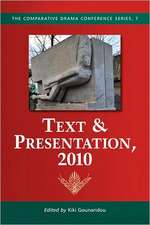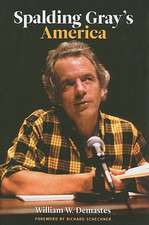A Teacher’s Guide to Musical Theatre
Autor Professor Kenneth Pickering, Professor David Hensonen Limba Engleză Paperback – 22 sep 2021
| Toate formatele și edițiile | Preț | Express |
|---|---|---|
| Paperback (1) | 114.50 lei 3-5 săpt. | +22.24 lei 4-10 zile |
| Bloomsbury Publishing – 22 sep 2021 | 114.50 lei 3-5 săpt. | +22.24 lei 4-10 zile |
| Hardback (1) | 375.66 lei 6-8 săpt. | +80.06 lei 4-10 zile |
| Bloomsbury Publishing – 22 sep 2021 | 375.66 lei 6-8 săpt. | +80.06 lei 4-10 zile |
Preț: 114.50 lei
Preț vechi: 123.64 lei
-7% Nou
Puncte Express: 172
Preț estimativ în valută:
21.91€ • 22.79$ • 18.09£
21.91€ • 22.79$ • 18.09£
Carte disponibilă
Livrare economică 25 martie-08 aprilie
Livrare express 08-14 martie pentru 32.23 lei
Preluare comenzi: 021 569.72.76
Specificații
ISBN-13: 9781350213920
ISBN-10: 1350213926
Pagini: 184
Dimensiuni: 156 x 234 x 17 mm
Greutate: 0.32 kg
Editura: Bloomsbury Publishing
Colecția Methuen Drama
Locul publicării:London, United Kingdom
ISBN-10: 1350213926
Pagini: 184
Dimensiuni: 156 x 234 x 17 mm
Greutate: 0.32 kg
Editura: Bloomsbury Publishing
Colecția Methuen Drama
Locul publicării:London, United Kingdom
Caracteristici
Uses engaging methods that draw on examples from popular musicals such as Hamilton to ensure students remain connected to the field of study
Notă biografică
Professor David Henson is former Director of London College of Music with skills in directing, acting and musical theatre. Currently researching for a book publication in dialogue in the performance space. Have been responsible for creating postgraduate and undergraduate courses in Acting, Musical Theatre, Voice Studies, Acting & Theatre Making and Actor Musicianship courses in many conservatoires and universities including Royal Central School, London College of Music and Royal Conservatoire, Birmingham. Creator and writer of first Advanced Level Performing Arts and Chief Examiner for Advanced Level Music, Drama and Performing Arts plus vocational qualifications at all levels. Author of 3 publications in musical theatre and recently completed a chapter in Bloomsbury's Perspectives and Practices in popular Music Education.Professor Kenneth Pickering is currently lead assessor for the Council for Dance, Drama and Musical Theatre. Former Professor of Theatre at Gonzaga University, USA and Chief Examiner for Speech, Drama and Musical Theatre for the London College of Music and Trinity/Guildhall. Consultant to Rock School and Stagecoach Theatre Schools. Author of 13 published and widely performed plays and musicals and of Studying Modern Drama, Key Concepts in Drama and Performance, Drama Improvised, Drama in the Cathedral and co-author of Theatre Studies, Naturalism in Theatre, Choreographing the Stage Musical and two Workbooks for Musical Theatre (with David Henson). Recently completed a chapter on Peter Brook for Bloomsbury.
Cuprins
1. An introduction to the teaching of musical theatreEstablishing the principles of effective teaching in this field and emphasising the integrated nature of the subject, this chapter explains how the book may be used in a variety of ways. Each 'lesson' is envisaged as 2 x50 mins in a typical twelve- week semester.2. Lesson One: The Elements of Musical TheatreUsing a simple narrative song as an example, this chapter explores and establishes the basic elements and possibilities of musical theatre.3. Lesson Two: What do you mean?Acting in musical theatre. This chapter establishes the concept of 'acting through song' and provides the basis for performance approaches throughout the book.4. Lesson Three: Play the dots? The art and use of accompaniment. The chapter discusses the use of various forms of accompaniment and establishes the best ways for teachers to work with live and recorded music.5. Lesson Four: 'I could have danced all night': What about choreography? What and how do we teach the integration of music, movement and acting? What is the purpose of dance and how has the 'dance musical' evolved? Projects and explorations involving various dance forms and the role of the choreographer6. Lesson Five: Where did it all start?Exploring the history of the development of this art form to enable students to place their work in context.7. Lesson Six: The 'Biz'. Here we look at the way in which the theatre often celebrates and explores itself through shows: e.g. 'Cabaret' 'Sweet Charity',' Kiss me Kate', 'A Chorus Line'.8. Lesson Seven: 'Pogroms in the East'Some key historical facts describing the effect of migration from the Opera Houses of Europe to the USA by predominantly Jewish musicians. We then consider the diversity of musical theatre and the influences of black culture; minstrel shows and jazz together with the influence of various other ethnic groups. The creation of the Broadway and Hollywood musical scene.9. Lesson Eight: Chorus time. Many students regard being cast as a member of the chorus as a disappointment, but the chorus is now an integral 'main character'. This was not always the case. (see Berlioz and his comment on the behaviour of the chorus in Paris Opera Houses in his 'Memoirs' and G and S's work to eradicate this lack of discipline etc).We now explore precisely what a chorus does in 'A Chorus Line' or 'JCSS'. and create tasks to develop the ideas touched in on Lesson One.10. Lesson Nine: Patter, Hamilton and Gilbert and Sullivan. The recent revival of 'The Mikado' by Jonathan Miller (giving it an 'after life' as he likes to call it) suggests that we ought to reintroduce the work of G and S to a generation that is largely ignorant of it and then link the patter songs with the rap of 'Hamilton'.
Recenzii
David Henson and Kenneth Pickering have encapsulated the key ingredients to producing successful, engaging, enjoyable and beautifully paced lessons that can be adapted to suit any teaching environment ... Whether you are a new or experienced teacher, this superbly written book has plenty of gems and treasures that will add value, broaden your teaching, and engage your students ... A must buy!
A helping hand for teachers embarking on central bases of music theatre with their students . There are fantastic ideas for lessons.
A helping hand for teachers embarking on central bases of music theatre with their students . There are fantastic ideas for lessons.





















